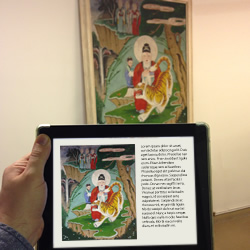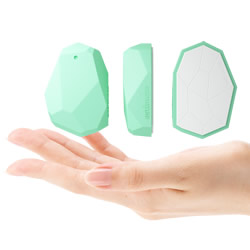Museums increasingly look to smartphone apps to provide guides and interpretation for visitors. Of course this technology is still in its infancy and has certain inevitable drawbacks – not least matching what is on the screen to what the visitor is looking at. A new technology called Bluetooth Beacons is promising to solve this problem, improving the experience of using these apps for visitors and making exciting new means of interaction possible.
Imagine a time not too far in the future where most visitors are using your museum’s guide app on a smartphone or tablet. As they stand in front of a particular item, their device immediately bursts into life, displaying information about that exhibit and its creator. They scroll through the information and watch a video about its history. Clicking another tab shows which of their friends from their own social networks have stood and looked at the same piece. Pressing another button pops up guide arrows, pointing to other pieces in the gallery like a miniature sat-nav, to show work linked by artist, theme or history. And all without scanning any ugly QR codes or manually choosing items from a catalogue.

Bluetooth Beacons are tiny pieces of equipment which can be installed and hidden around your gallery and exhibits. Typically around 2” across, as the name suggests they act as tiny beacons sending out a bluetooth signal to any suitably equipped smartphones or tablets nearby. These signals can be picked up by your app, and their proximity measured. This enables the app to know whether you are close to a specific beacon – if these are associated with a particular exhibit, the app can then recognise which item the visitor is standing in front of and display appropriate information.
What’s more, as long as you have three or more beacons, the device can triangulate its position between them and identify its location. This essentially enables apps to have a highly sensitive indoor GPS accurate to centimetres, rather than the 10m accuracy of satellite GPS.
Such accurate sensing of its position allows apps using it to provide a much more user-friendly experience – instead of asking users to scan a QR code, or input a number to view appropriate information for an artefact, the app will just “know” where they are standing and what they are looking at.
The beacon hardware is low maintenance, and typically running off a “button” type battery for up to 2 years. This means no wiring is required to install them, and they can be hidden within plinths, labels or displays. They have a range of between 10cm and 70m.
Technically, they use a standard called Bluetooth LE (Low Energy). Although this technology has been around since 2006, it is only in the last couple of years that the majority of smartphones have begun to support it. As the name suggests it has a major advantage over standard Bluetooth as it uses vastly less energy, which means phones can “listen out” for signals and communicate continuously without affecting battery life. It is now supported by all current iPhones and recent Android-based phones.
However the technology has really gained attention in the last few months as Apple included their own developer-friendly implementation of it in iOS7, naming it iBeacons. It has been designed so that users don’t even have to have the app open on their screen for it to work.
The technology is so cutting edge there are very few examples of it out in the wild. However major players are taking a keen interest in it. For example Paypal has developed a system (simply called Beacon) for retailers which detects when users of its payment app are in range, and allows them to pay directly for purchases.
Beyond providing straightforward interactive interpretation and guides related to items near the user, it could be used to create virtual treasure hunts, guided tours or augmented reality experiences. They also offer opportunities to improve commerce and revenue – for example to give visitors special offers for the cafe when they are near it; provide recommendations of what to buy in the gift shop based on what items they have viewed during their visit and guide them to the right shelf to pick them up; or to request a donation as people pass through the front door. Visitors could opt to record their visits, choosing to relive them virtually afterwards by viewing the same items online (perhaps taking in extra information they didn’t have time to take in during a physical visit). They could even share whole visits on their social networks, effortlessly creating user-generated guides for other visitors to follow.
Some of the Bluetooth beacon designs wouldn’t themselves appears out of place in a modern art gallery. For example Estimote’s beacons look like irregular, multi-faceted jewels and come in a variety of vibrant colours. Current versions from companies such as Estimote, Bleep and Roximity cost in the region of £20 each, and as the technology becomes commoditised and the far-East begins to mass-produce unbranded versions become available, prices and physical sizes are likely to drop to a point where the hardware and maintenance costs are negligible.

The ongoing rise of smartphone-app based museum guides and experiences seems inevitable, and Bluetooth Beacons seem like they will play a key role in opening up creative, interpretative and commercial opportunities, and making these apps more user-friendly for users.
Back to top




